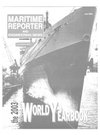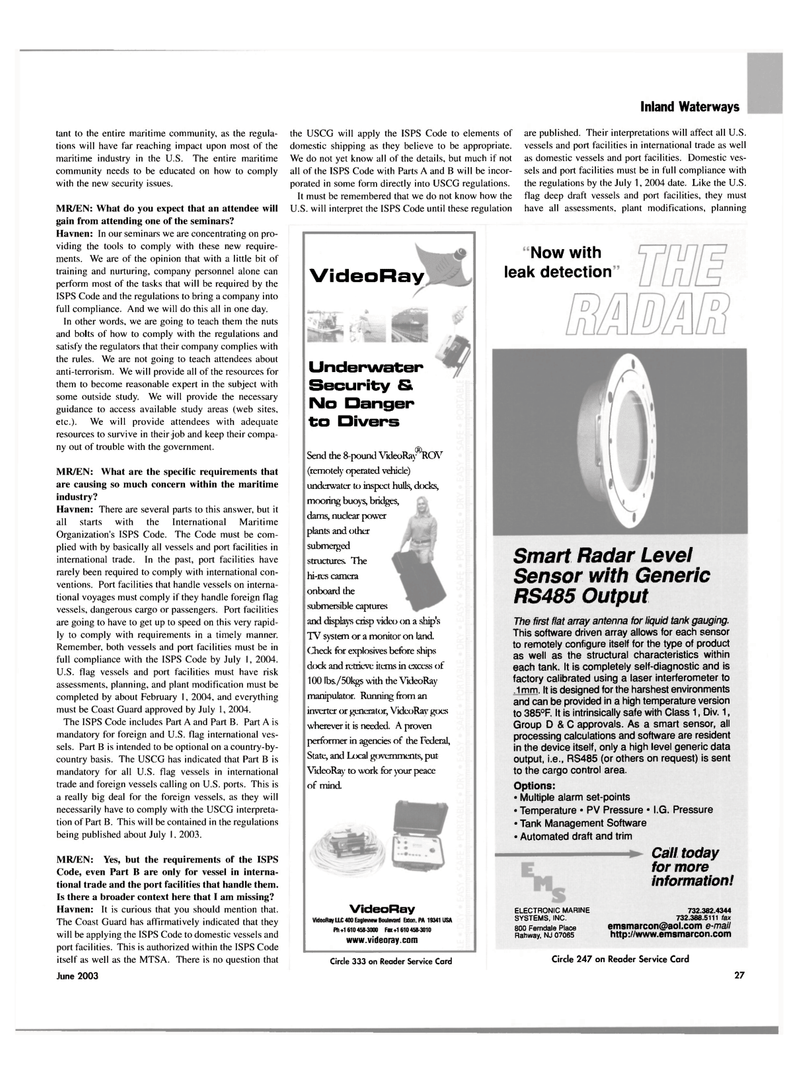
Page 27: of Maritime Reporter Magazine (June 2003)
Read this page in Pdf, Flash or Html5 edition of June 2003 Maritime Reporter Magazine
Inland Waterways tant to the entire maritime community, as the regula- tions will have far reaching impact upon most of the maritime industry in the U.S. The entire maritime community needs to be educated on how to comply with the new security issues.
MR/EN: What do you expect that an attendee will gain from attending one of the seminars?
Havnen: In our seminars we are concentrating on pro- viding the tools to comply with these new require- ments. We are of the opinion that with a little bit of training and nurturing, company personnel alone can perform most of the tasks that will be required by the
ISPS Code and the regulations to bring a company into full compliance. And we will do this all in one day.
In other words, we are going to teach them the nuts and bolts of how to comply with the regulations and satisfy the regulators that their company complies with the rules. We are not going to teach attendees about anti-terrorism. We will provide all of the resources for them to become reasonable expert in the subject with some outside study. We will provide the necessary guidance to access available study areas (web sites, etc.). We will provide attendees with adequate resources to survive in their job and keep their compa- ny out of trouble with the government.
MR/EN: What are the specific requirements that are causing so much concern within the maritime industry?
Havnen: There are several parts to this answer, but it all starts with the International Maritime
Organization's ISPS Code. The Code must be com- plied with by basically all vessels and port facilities in international trade. In the past, port facilities have rarely been required to comply with international con- ventions. Port facilities that handle vessels on interna- tional voyages must comply if they handle foreign flag vessels, dangerous cargo or passengers. Port facilities are going to have to get up to speed on this very rapid- ly to comply with requirements in a timely manner.
Remember, both vessels and port facilities must be in full compliance with the ISPS Code by July I, 2004.
U.S. flag vessels and port facilities must have risk assessments, planning, and plant modification must be completed by about February 1, 2004, and everything must be Coast Guard approved by July 1, 2004.
The ISPS Code includes Part A and Part B. Part A is mandatory for foreign and U.S. flag international ves- sels. Part B is intended to be optional on a country-by- country basis. The USCG has indicated that Part B is mandatory for all U.S. flag vessels in international trade and foreign vessels calling on U.S. ports. This is a really big deal for the foreign vessels, as they will necessarily have to comply with the USCG interpreta- tion of Part B. This will be contained in the regulations being published about July I. 2003.
MR/EN: Yes, but the requirements of the ISPS
Code, even Part B are only for vessel in interna- tional trade and the port facilities that handle them.
Is there a broader context here that I am missing?
Havnen: It is curious that you should mention that.
The Coast Guard has affirmatively indicated that they will be applying the ISPS Code to domestic vessels and port facilities. This is authorized within the ISPS Code itself as well as the MTSA. There is no question that
June 2003 the USCG will apply the ISPS Code to elements of domestic shipping as they believe to be appropriate.
We do not yet know all of the details, but much if not all of the ISPS Code with Parts A and B will be incor- porated in some form directly into USCG regulations.
It must be remembered that we do not know how the
U.S. will interpret the ISPS Code until these regulation are published. Their interpretations will affect all U.S. vessels and port facilities in international trade as well as domestic vessels and port facilities. Domestic ves- sels and port facilities must be in full compliance with the regulations by the July 1, 2004 date. Like the U.S. flag deep draft vessels and port facilities, they must have all assessments, plant modifications, planning
VideoRay
Underwater
Security &
No Danger to Divers
Send the 8-pound VideoRay®ROV (remotely operated vehicle) underwater to inspect hulls, docks, mooring buoys, bridges, dams, nuclear power plants and other submerged structures. The hi-res camera onboard the submersible captures and displays crisp video on a ship's
TV system or a monitor on land.
Cheek for explosives before ships dock and retrieve items in exccss of 100 lbs./50kgs with die VideoRay manipulator. Running from an inverter or generator, VideoRay goes wherever it is needed. A proven performer in agencies of the Federal,
State, and Local governments, put
VideoRay to work for your peace of mind.
VideoRay
VideoRay LLC 400 Eagleview Boulevard Exton, PA 19341 USA
PI) +1 610 458-3000 Fax +1 610 458-3010 www.videoray.com
Now with leak detection
Smart Radar Level
Sensor with Generic
RS485 Output
The first flat array antenna for liquid tank gauging.
This software driven array allows for each sensor to remotely configure itself for the type of product as well as the structural characteristics within each tank. It is completely self-diagnostic and is factory calibrated using a laser interferometer to •1mm. It is designed for the harshest environments and can be provided in a high temperature version to 385°F. It is intrinsically safe with Class 1, Div. 1,
Group D & C approvals. As a smart sensor, all processing calculations and software are resident in the device itself, only a high level generic data output, i.e., RS485 (or others on request) is sent to the cargo control area.
Options: • Multiple alarm set-points • Temperature • PV Pressure • I.G. Pressure • Tank Management Software • Automated draft and trim
ELECTRONIC MARINE
SYSTEMS, INC. 800 Ferndale Place
Rahway, NJ 07065
Call today for more information! 732.382.4344 732.388.5111 fax [email protected] e-mail http://www.emsmarcon.com
Circle 333 on Reader Service Card Circle 247 on Reader Service Card 27

 26
26

 28
28
